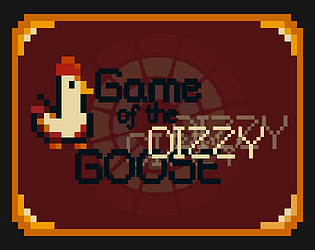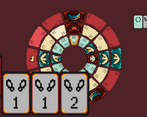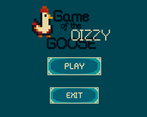Play game
Game of the Dizzy Goose's itch.io pageResults
| Criteria | Rank | Score* | Raw Score |
| Overall | #4 | 3.417 | 3.417 |
| Features & Additions | #4 | 3.444 | 3.444 |
| Creativity | #4 | 3.778 | 3.778 |
| Gameplay Implementation | #5 | 3.556 | 3.556 |
| Code + Technical | #6 | n/a | n/a |
| UI/UX Consideration | #9 | 2.889 | 2.889 |
Ranked from 9 ratings. Score is adjusted from raw score by the median number of ratings per game in the jam.
Judge feedback
Judge feedback is anonymous and shown in a random order.
- Original! A bit hard to understand what to do and what happened!
- Great documentation Intrigued to see the code, given how the candidate is suggesting they were working in C++ for the first time Hard to tell which player is currently controlled Nice art for the board Messy release zip Was able to complete the game - takes a little while to understand the rules but they appear to be well implemented - there may be some corner cases in there but haven't played enough - good work. Not sure if being able to see the other players cards is a game strategic element or a limitation of playing on a single machine.
- You should be very proud of yourself for taking on this challenge and learning C++. Don't be disappointed that the game isn't as polished as you had hoped for, it's a great sign that you are aware of what needs more work & fine tuning. I can tell by the documentation that you are passionate about creating games and interested in the design process. It's also very cool to see that you've found a specific interest in AI Programming and incorporated that into your game. Keep learning and taking on scary challenges! <3
- At first look this submission looked strong. The game page is well detailed and creative. The look of the game is good, but the rules are very quickly lost on the player as there is no visual feedback on their actions. I expected this to be a game against the AI, so was disappointed that I had to make all the moves for both geese. On that point, the visual design is not very friendly towards someone with colour-blindness, and I was sometimes unsure which goose I was about to manipulate. A few small tweaks could make this game really good. 1. Better colour difference between the players. 2. In game tutorial of what the cards do. 3. Show the players moves step by step. Preferably with some animations. 4. Change the rotation cards to show clockwise/anticlockwise rather than right/left, as the selection made didn't seem to match the rotation result.
- The project is an interesting and creative fusion of the starter project and the board game "The Game of the Goose" with its novel spin. The biggest shortcomings of this submission lie in the UX. The three major points are: - Your cards cover a big part of the board and make it hard to see what going on - Lack of tutorial/tooltips inside the game makes it hard to figure out how the game works without reading external documentation - Limited feedback on the effect of your played cards Improvements to these points would have greatly improved how quickly a player understands the game and the impact of their actions. The participant self-reported underestimating the time required to get the core implementation but adapted well by using a paper prototype to further develop the design before completing the implementation. They prioritized well and managed to design and implement the core gameplay loop with an AI opponent. In my opinion, the original plan of using MCTS while interesting was an overkill and out of scope for this project from the beginning. The adjusted plan to use utility AI better fits the game design and the time and skill constraints. Overall the project and planning showed potential. With more time for polishing and bug fixing game would likely become a fun experience.
- This is a really cool submission, even if it took me a few play throughs to understand the mechanics. I still don't quite get what makes me go down a ring, but the rest of it makes sense and is a solid little minigame. UX wise what I think could have really helped with understanding the game rules would be to animate the ducks as they move the positions, it would make it easier to figure out from observing what does what. Also, the cards obscure quite a large portion of the screen meaning you can't see the duck quite a lot of the time which didn't help. Maybe having a dedicated card area towards the bottom, like Hearthstone uses. That keeps the actual play area unobscured and always visible. That would also give you the chance to have the player two deck in a separate location on the screen so clearly indicate who is currently playing. Your animations for the ring rotation cards are swish. I generally really like the visual style you have going on as well. You said it's your first time with pixel art too? I'd say you'd nailed it. Excellent write-up by the way. Building a physical model like you did can be wonderful for prototyping games like these. Your reflection also is balanced and you identify a lot of areas you can look into improving later. All in all, well done on this excellent little minigame with a cohesive well done pixel art style, plus a professionally formatted writeup.
Challenge Tier
Search For A Star
Leave a comment
Log in with itch.io to leave a comment.





Comments
No one has posted a comment yet